Polarization-Flexible and Frequency-Scanning Leaky-Wave HMSIW Antenna for Vehicular Applications
Abstract
:1. Introduction
2. The Designed Antenna and Its Operational Principle
2.1. The Designed Antenna Structure
2.2. Operational Principle
3. The Key Design Considerations
3.1. Dimensions of the SIW and HMSIW
3.2. The 3 dB SIW Directional Coupler
3.3. The Interdigital Slot Antennas
3.4. The Positioning of the Two Interdigital Slot Antennas
4. Experimental Results
5. Conclusions
Author Contributions
Funding
Data Availability Statement
Conflicts of Interest
References
- Ge, X.; Cheng, H.; Mao, G.; Yang, Y.; Tu, S. Vehicular Communications for 5G Cooperative Small-Cell Networks. IEEE Trans. Veh. Technol. 2016, 65, 7882–7894. [Google Scholar] [CrossRef] [Green Version]
- Ge, L.; Gao, S.; Li, Y.; Qin, W.; Wang, J. A Low-Profile Dual-Band Antenna With Different Polarization and Radiation Properties Over Two Bands for Vehicular Communications. IEEE Trans. Veh. Technol. 2019, 68, 1004–1008. [Google Scholar] [CrossRef]
- Dudek, M.; Nasr, I.; Bozsik, G.; Hamouda, M.; Kissinger, D.; Fischer, G. System Analysis of a Phased-Array Radar Applying Adaptive Beam-Control for Future Automotive Safety Applications. IEEE Trans. Veh. Technol. 2015, 64, 34–47. [Google Scholar] [CrossRef]
- Jeon, S.Y.; Ka, M.H.; Shin, S.; Kim, M.; Kim, S.; Kim, S.; Kim, J.; Dewantari, A.; Kim, J.; Chung, H. W-Band MIMO FMCW Radar System With Simultaneous Transmission of Orthogonal Waveforms for High-Resolution Imaging. IEEE Trans. Microw. Theory Tech. 2018, 66, 5051–5064. [Google Scholar] [CrossRef]
- Brunetti, G.; Armenise, M.; Ciminelli, C. Chip-Scaled Ka-Band Photonic Linearly Chirped Microwave Waveform Generator. Front. Phys. 2022, 10, 785650. [Google Scholar] [CrossRef]
- Khilo, A.; Spector, S.; Grein, M.; Nejadmalayeri, A.; Holzwarth, C. Photonic ADC: Overcoming the bottleneck of electronic jitter. Opt. Express 2012, 20, 4454–4469. [Google Scholar] [CrossRef]
- Xiao, X.; Li, S.; Chen, B.; Yang, X.; Wu, D.; Xue, X.; Zheng, X.; Zhou, B. A microwave photonics-based inverse synthetic aperture radar system. In Proceedings of the 2017 Conference on Lasers and Electro-Optics (CLEO), San Jose, CA, USA, 14–19 May 2017; pp. 1–2. [Google Scholar]
- Ishimaru, A.; Tuan, H. Frequency scanning antennas. In 1958 IRE International Convention Record; IEEE: Piscataway, NJ, USA, 1961; pp. 101–109. [Google Scholar]
- Mohsen, M.; Isa, M.; Isa, A.; Abdulhameed, M.; Attiah, M. Achieving Fixed-Frequency Beam Scanning With a Microstrip Leaky-Wave Antenna Using Double-Gap Capacitor Technique. IEEE Antennas Wirel. Propag. Lett. 2019, 18, 1502–1506. [Google Scholar] [CrossRef]
- Rahmani, M.; Deslandes, D. Backward to Forward Scanning Periodic Leaky-Wave Antenna With Wide Scanning Range. IEEE Trans. Antennas Propag. 2017, 65, 3326–3335. [Google Scholar] [CrossRef]
- Wu, G.; Wang, G.; Liang, J.; Gao, X. Dual-band periodic beam scanning antenna using eighth mode substrate integrated waveguide based metamaterial transmission line. J. Phys. D-Appl. Phys. 2017, 50, 1–8. [Google Scholar] [CrossRef]
- Xie, S.; Li, J.; Deng, G.; Feng, J.; Xiao, S. A Wide-Angle Scanning Leaky-Wave Antenna Based on a Composite Right/Left-Handed Transmission Line. Appl. Sci. 2020, 10, 1927. [Google Scholar] [CrossRef] [Green Version]
- Li, Y.; Zhang, Z.; Zheng, J.; Feng, Z. Channel capacity study of polarization reconfigurable slot antenna for indoor MIMO system. Microw. Opt. Technol. Lett. 2011, 53, 1209–1213. [Google Scholar] [CrossRef]
- Kovitz, J.; Rajagopalan, H.; Rahmat-Samii, Y. Design and Implementation of Broadband MEMS RHCP/LHCP Reconfigurable Arrays Using Rotated E-Shaped Patch Elements. IEEE Trans. Antennas Propag. 2015, 63, 2497–2507. [Google Scholar] [CrossRef]
- Grau, A.; Romeu, J.; Lee, M.; Blanch, S.; Jofre, L.; De Flaviis, F. A Dual-Linearly-Polarized MEMS-Reconfigurable Antenna for Narrowband MIMO Communication Systems. IEEE Trans. Antennas Propag. 2010, 58, 4–17. [Google Scholar] [CrossRef]
- Fartookzadeh, M.; Mohseni Armaki, S. Circular feeding network for circular polarization reconfigurable antennas. Electron. Lett. 2019, 55, 677–679. [Google Scholar] [CrossRef]
- Yang, L.; Yang, L.; Zhu, Y.; Yoshitomi, K.; Kanaya, H. Polarization reconfigurable slot antenna for 5.8 GHz wireless applications. Aeu-Int. J. Electron. Commun. 2019, 101, 27–32. [Google Scholar] [CrossRef]
- Seongmin, P.; Youngje, S. A circular polarized microstrip antenna with an arrow-shaped slotted ground. Microw. Opt. Technol. Lett. 2012, 54, 271–273. [Google Scholar]
- Shu, C.; Wang, J.; Hu, S.; Yao, Y.; Yu, J.; Alfadhl, Y.; Chen, X. A Wideband Dual-Circular-Polarization Horn Antenna for mmWave Wireless Communications. IEEE Antennas Wirel. Propag. Lett. 2019, 18, 1726–1730. [Google Scholar] [CrossRef]
- McMichael, I. A Mechanically Reconfigurable Patch Antenna With Polarization Diversity. IEEE Antennas Wirel. Propag. Lett. 2018, 17, 1186–1189. [Google Scholar] [CrossRef]
- Karamzadeh, S.; Rafii, V.; Saygin, H.; Kartal, M. Polarisation diversity cavity back reconfigurable array antenna for C-band application. IET Microw. Antennas Propag. 2016, 10, 955–960. [Google Scholar] [CrossRef]
- Lim, J.; Back, G.; Yun, T. Polarization-diversity cross-shaped patch antenna for satellite-DMB systems. ETRI J. 2010, 32, 312–318. [Google Scholar] [CrossRef]
- Suntives, A.; Hum, S. A Fixed-Frequency Beam-Steerable Half-Mode Substrate Integrated Waveguide Leaky-Wave Antenna. IEEE Trans. Antennas Propag. 2012, 60, 2540–2544. [Google Scholar] [CrossRef]
- Liu, J.; Jackson, D.; Long, Y. Substrate Integrated Waveguide (SIW) Leaky-Wave Antenna With Transverse Slots. IEEE Trans. Antennas Propag. 2012, 60, 20–29. [Google Scholar] [CrossRef]
- Dong, Y.; Itoh, T. Composite Right/Left-Handed Substrate Integrated Waveguide and Half Mode Substrate Integrated Waveguide Leaky-Wave Structures. IEEE Trans. Antennas Propag. 2011, 59, 767–775. [Google Scholar] [CrossRef]
- Pourghorban Saghati, A.; Mirsalehi, M.; Neshati, M. A HMSIW Circularly Polarized Leaky-Wave Antenna With Backward, Broadside, and Forward Radiation. IEEE Antennas Wirel. Propag. Lett. 2014, 13, 451–454. [Google Scholar] [CrossRef]
- Dong, Y.; Itoh, T. Substrate Integrated Composite Right-/Left-Handed Leaky-Wave Structure for Polarization-Flexible Antenna Application. IEEE Trans. Antennas Propag. 2012, 60, 760–771. [Google Scholar] [CrossRef]
- Xu, F.; Wu, K. Guided-wave and leakage characteristics of substrate integrated waveguide. IEEE Trans. Microw. Theory Tech. 2005, 53, 66–73. [Google Scholar]
- Cassivi, Y.; Perregrini, L.; Arcioni, P.; Bressan, M.; Wu, K.; Conciauro, G. Dispersion characteristics of substrate integrated rectangular waveguide. IEEE Microw. Wirel. Compon. Lett. 2002, 12, 333–335. [Google Scholar] [CrossRef]
- Liu, B.; Hong, W.; Wang, Y.; Lai, Q.; Wu, K. Half Mode Substrate Integrated Waveguide (HMSIW) 3-dB Coupler. IEEE Microw. Wirel. Compon. Lett. 2007, 17, 22–24. [Google Scholar] [CrossRef]


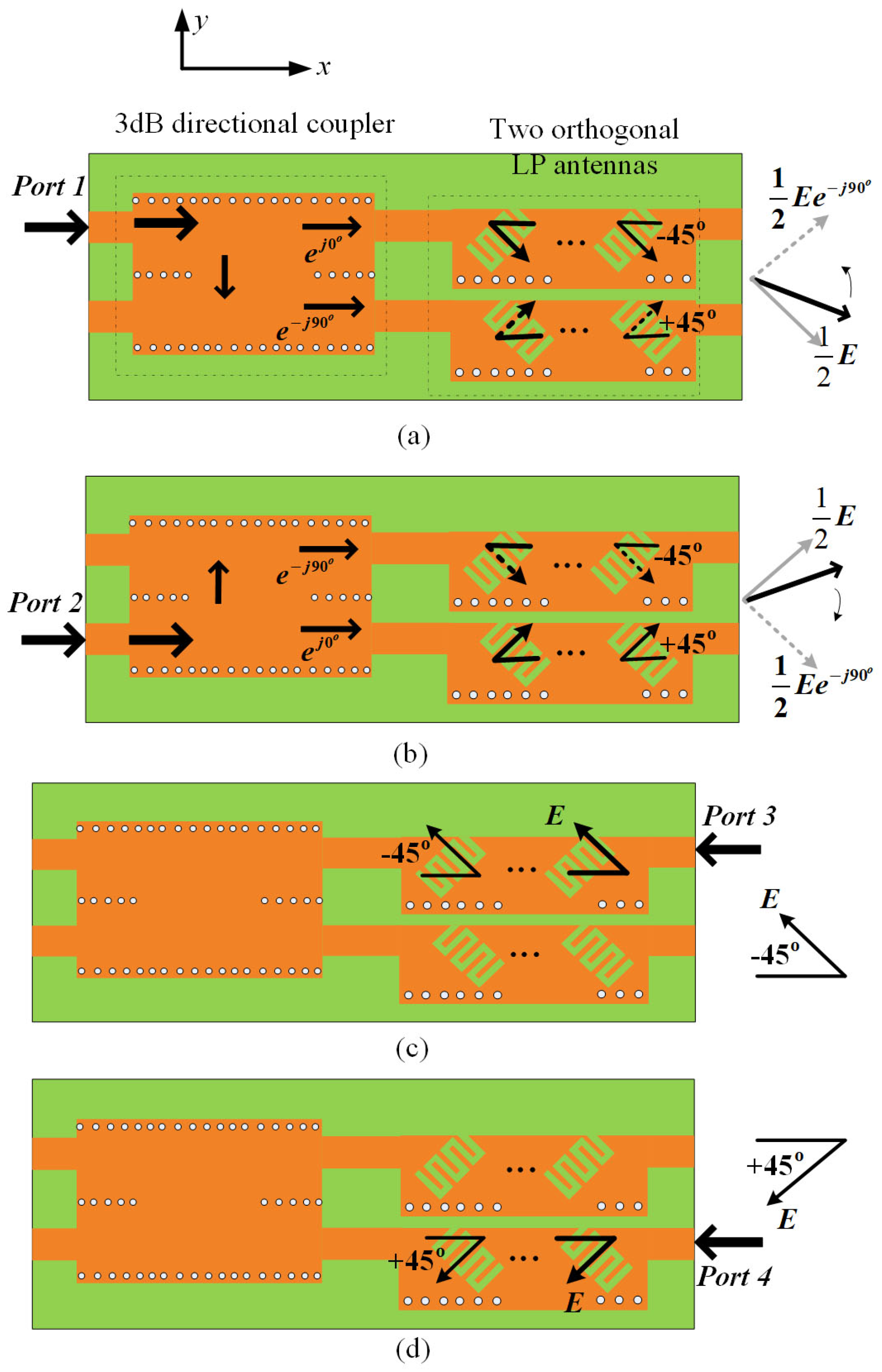
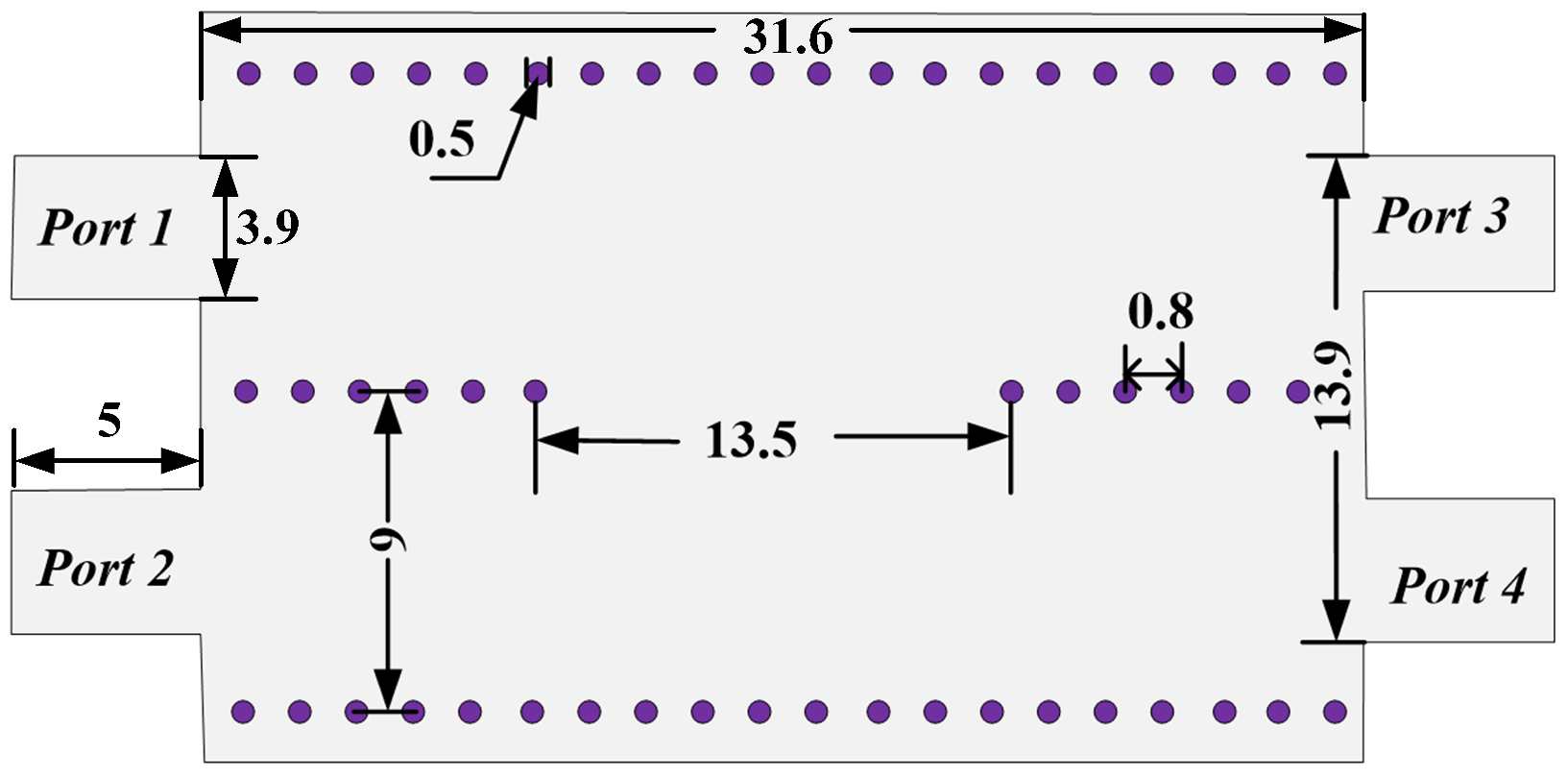
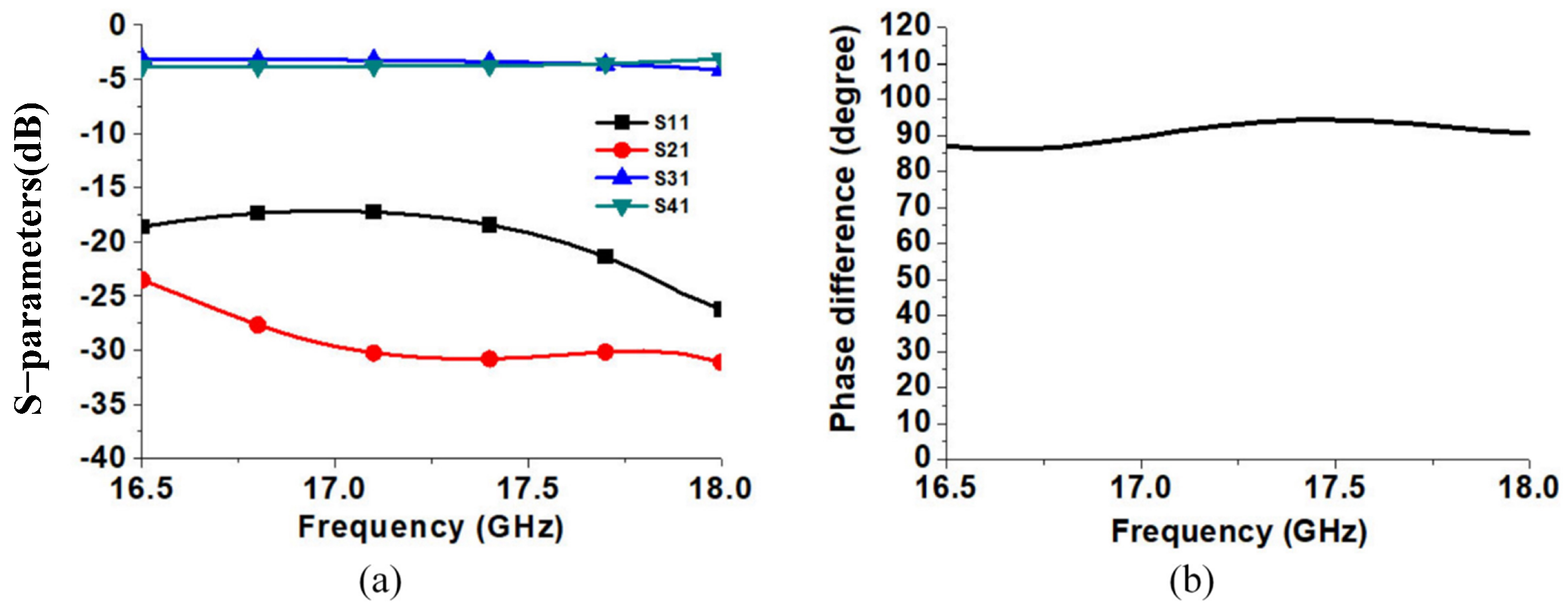

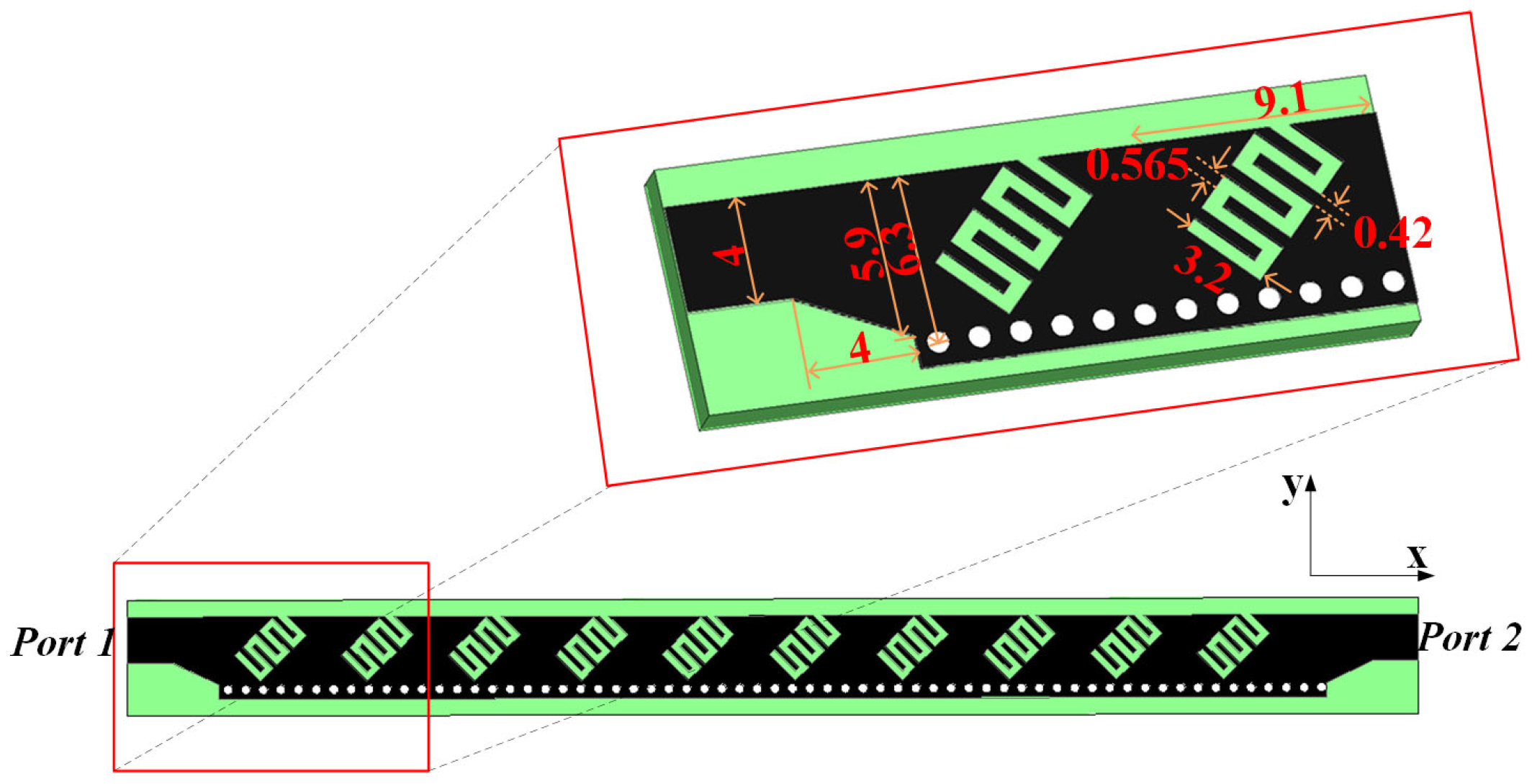


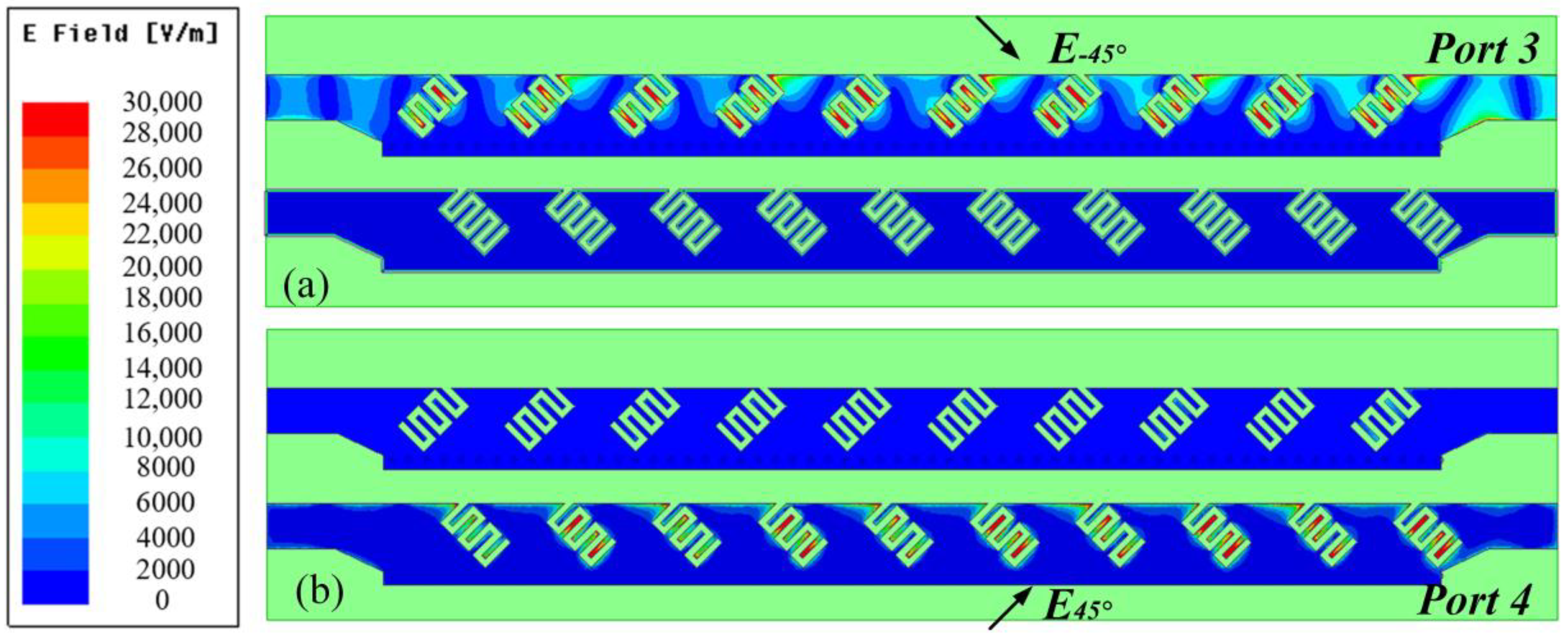

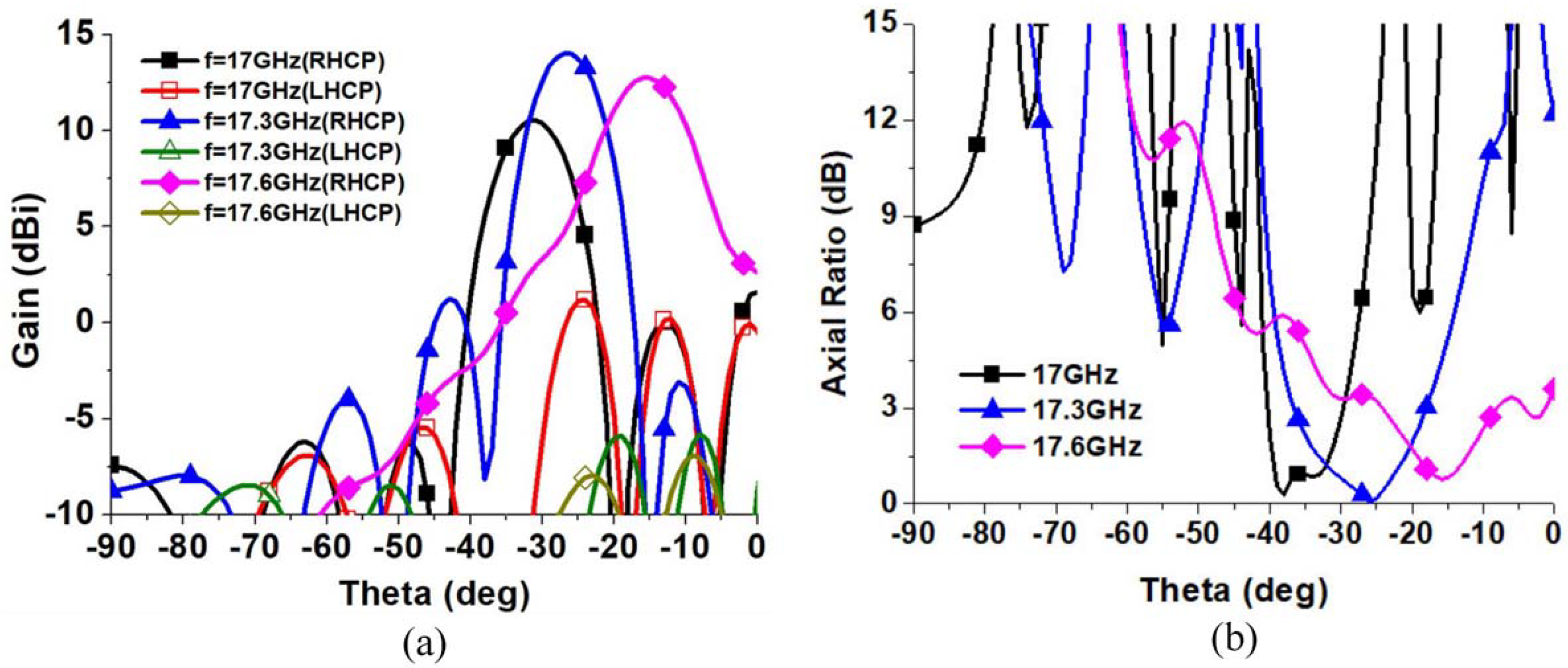
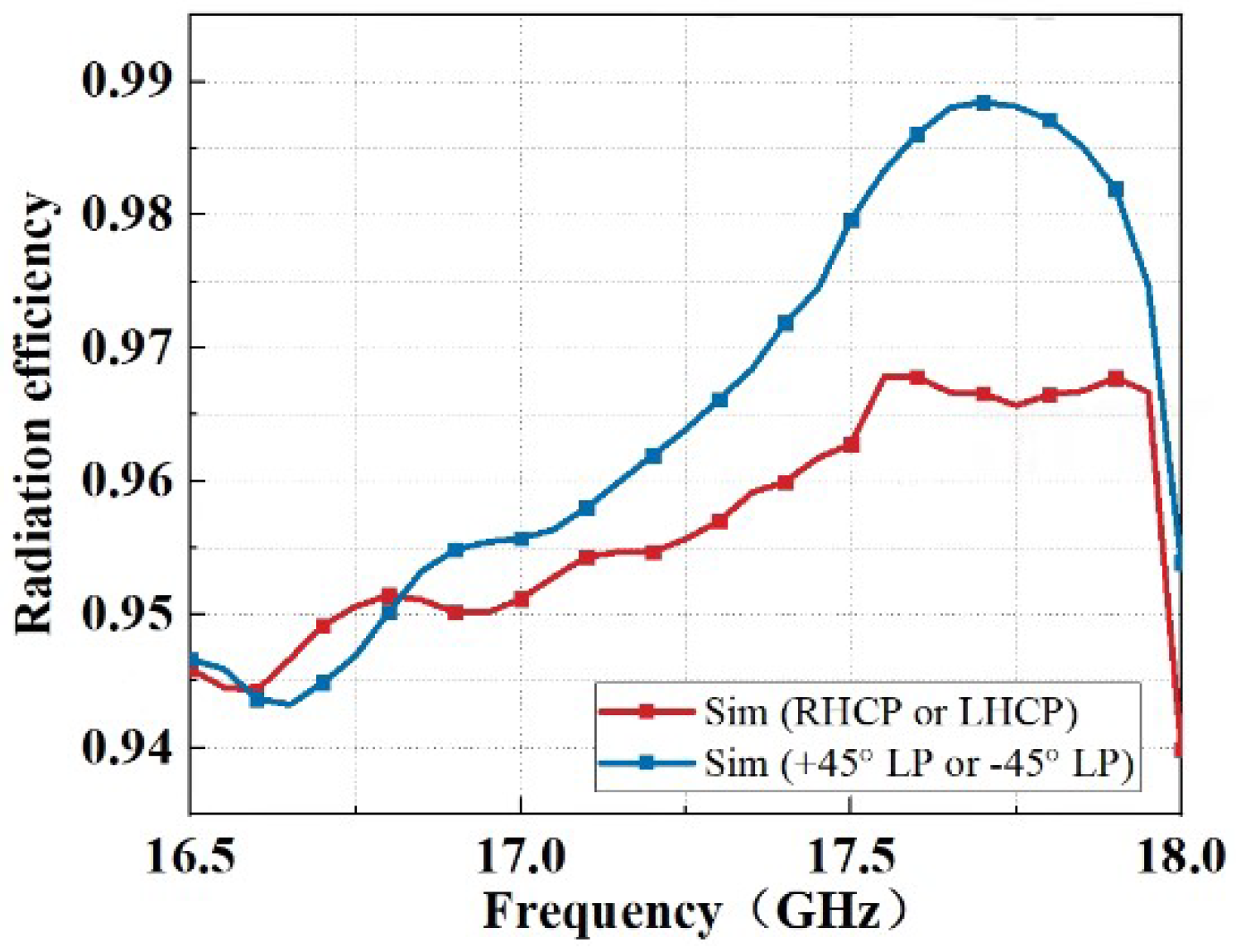



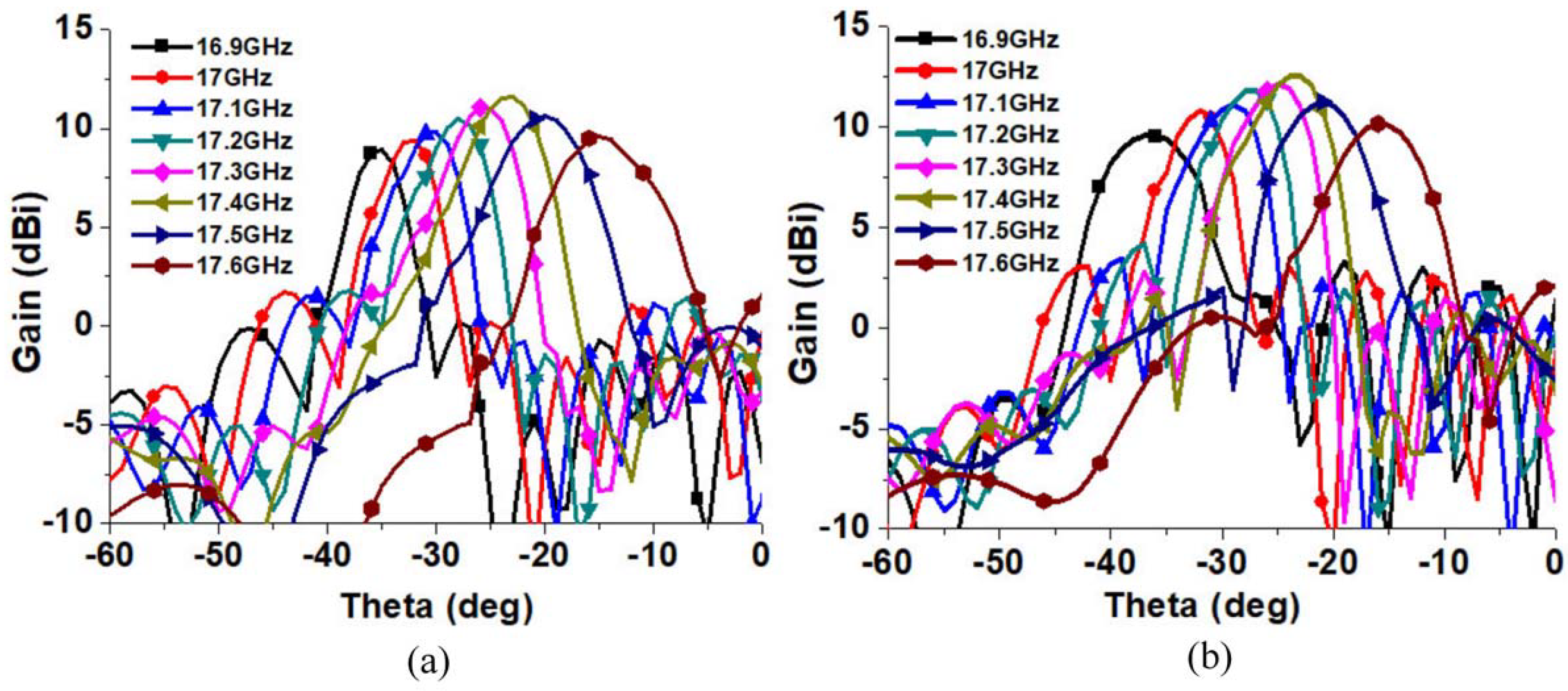

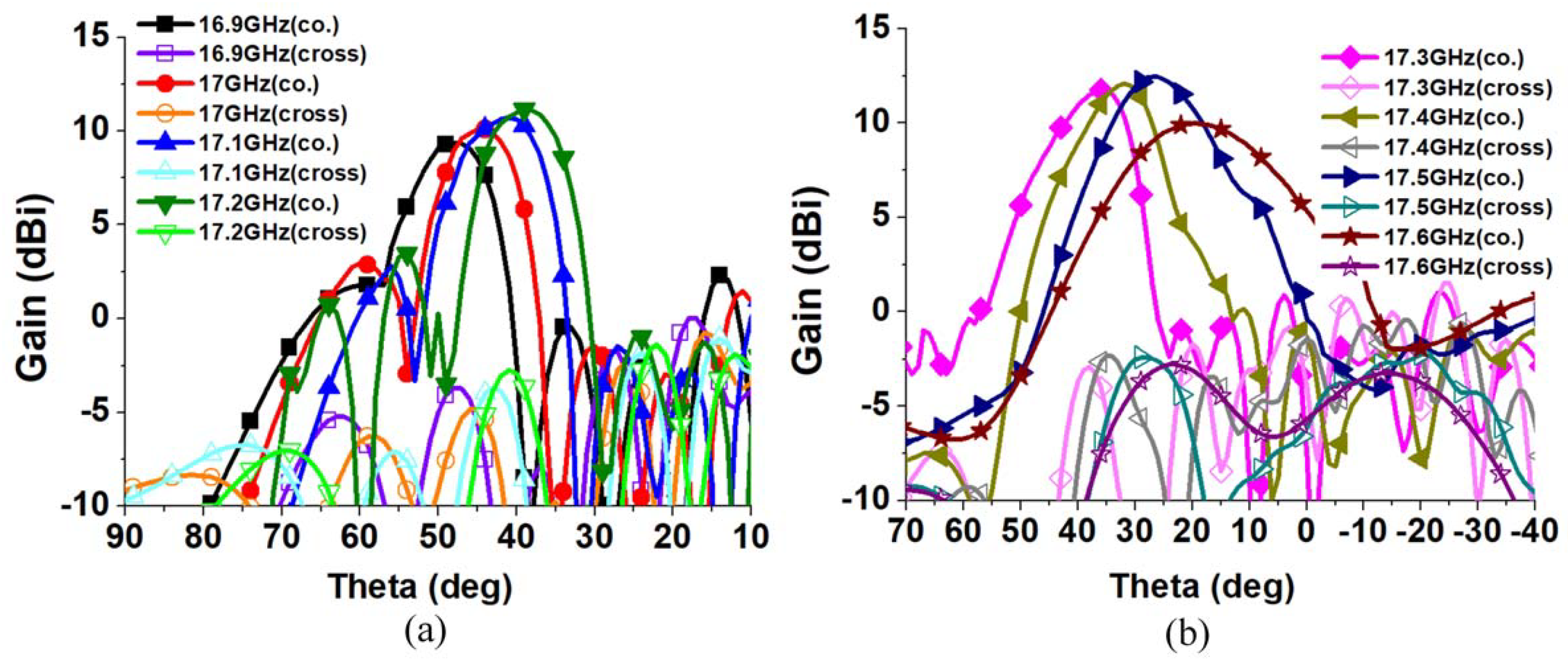
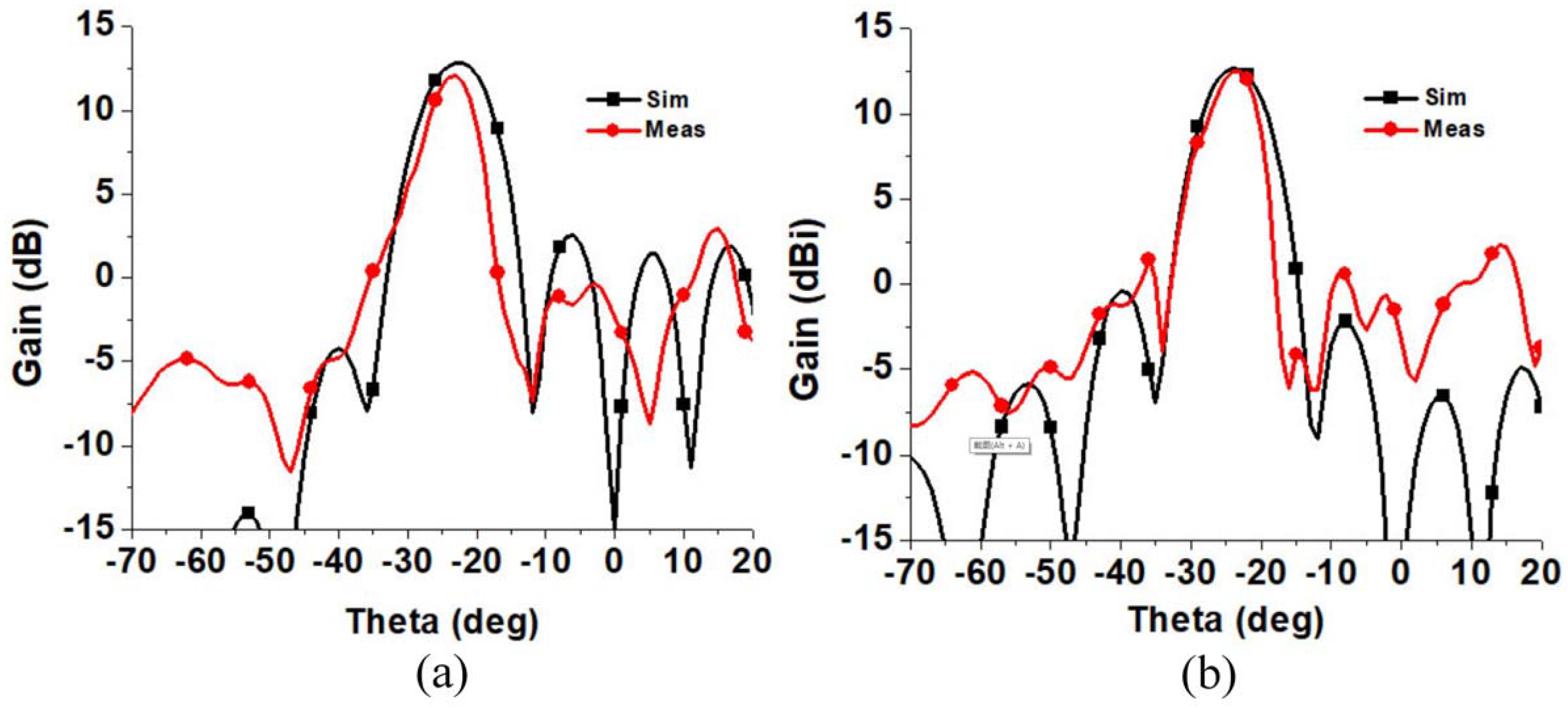

| CP | Frequency (GHz) | 17.0 Sim/Meas | 17.3 Sim/Meas | 17.6 Sim/Meas |
|---|---|---|---|---|
| RHCP | Beam direction Peak gain (dBi) 3 dB beam-width AR at (dB) | −31/−32 10.0/9.4 9/8 1.8/NA | −25 /-26 12.1/11.0 11/8 0.16/NA | −15/−15 11.8/9.7 13/10 0.81/NA |
| LHCP | Beam direction Peak gain (dBi) 3 dB beam-width AR at (dB) | −33/−32 11.2/10.8 10/8 0.89/NA | −25 /−25 12.5/12.1 10/8 1.34/NA | −15/−16 11.2/10.2 12/9 1.73/NA |
| LP | Frequency (GHz) | 17.0 Sim/Meas | 17.3 Sim/Meas | 17.6 Sim/Meas |
|---|---|---|---|---|
| −45 LP | Beam direction Peak gain (dBi) 3 dB beam-width Cross-pol at (dB) | 44/44 10.4/9.6 14/10 −21.8/−11.3 | 35 /35 12.1/11.8 14/12 −11.7/−9.8 | 19/19 10.6/9.6 24/24 −13.5/−9.3 |
| +45 LP | Beam direction Peak gain (dBi) 3 dB beam-width Cross-pol at (dB) | 44/44 10.3/10.1 15/10 −10.6/−10.6 | 36 /36 12.3/11.8 14/13 −11.5/−9.3 | 19/19 10.7/10.0 23/26 −9.4/−6.6 |
Publisher’s Note: MDPI stays neutral with regard to jurisdictional claims in published maps and institutional affiliations. |
© 2022 by the authors. Licensee MDPI, Basel, Switzerland. This article is an open access article distributed under the terms and conditions of the Creative Commons Attribution (CC BY) license (https://creativecommons.org/licenses/by/4.0/).
Share and Cite
Chen, A.; Fu, X.; Jiang, W.; An, K. Polarization-Flexible and Frequency-Scanning Leaky-Wave HMSIW Antenna for Vehicular Applications. Electronics 2022, 11, 2103. https://doi.org/10.3390/electronics11132103
Chen A, Fu X, Jiang W, An K. Polarization-Flexible and Frequency-Scanning Leaky-Wave HMSIW Antenna for Vehicular Applications. Electronics. 2022; 11(13):2103. https://doi.org/10.3390/electronics11132103
Chicago/Turabian StyleChen, Aixin, Xuedong Fu, Weiwei Jiang, and Kang An. 2022. "Polarization-Flexible and Frequency-Scanning Leaky-Wave HMSIW Antenna for Vehicular Applications" Electronics 11, no. 13: 2103. https://doi.org/10.3390/electronics11132103
APA StyleChen, A., Fu, X., Jiang, W., & An, K. (2022). Polarization-Flexible and Frequency-Scanning Leaky-Wave HMSIW Antenna for Vehicular Applications. Electronics, 11(13), 2103. https://doi.org/10.3390/electronics11132103






